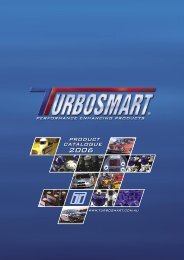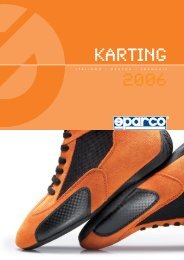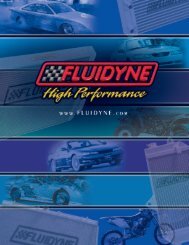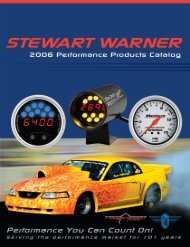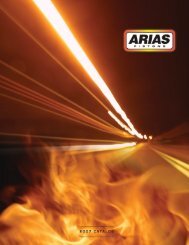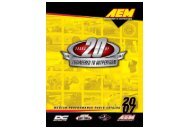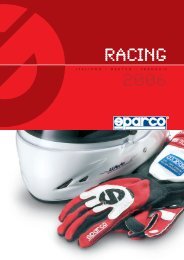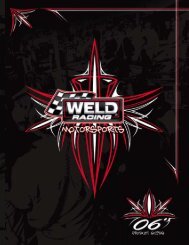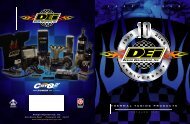Catalog Supplement for 2006 - JRP
Catalog Supplement for 2006 - JRP
Catalog Supplement for 2006 - JRP
You also want an ePaper? Increase the reach of your titles
YUMPU automatically turns print PDFs into web optimized ePapers that Google loves.
Standard High Per<strong>for</strong>mance<br />
Wave-Loc ®<br />
High Per<strong>for</strong>mance<br />
Pro Series<br />
Wave-Loc<br />
Choose From Three ARP<br />
Replacement Rod Bolts:<br />
Because factory connecting rods (or aftermarket versions of<br />
OEM rods) are used in a variety of applications from rebuilt stock<br />
motors to modified powerplants used in circle track, marine and<br />
drag racing engines – including those with superchargers and/or<br />
nitrous oxide injection systems – ARP offers replacement rod<br />
bolts in three different models. All of them are substantially better<br />
than the stock OEM and most aftermarket bolts.<br />
GOOD: STANDARD HIGH PERFORMANCE BOLTS<br />
A premium grade 8740 alloy chrome moly steel is used to<br />
manufacture ARP High Per<strong>for</strong>mance connecting rod bolts.<br />
This material is heat-treated to provide a tensile strength in<br />
the 200,000 psi range, which is substantially stronger than<br />
the OEM bolts. Cycle testing shows ARP High Per<strong>for</strong>mance<br />
rod bolts to be nearly five times more reliable than stock bolts.<br />
REPLACEMENT<br />
CONNECTING<br />
ROD BOLTS<br />
TECH NOTE: ROD BOLTS<br />
Unquestionably the most important fasteners in any<br />
engine are the connecting rod bolts, as they hold the key<br />
to the entire rotating assembly. A broken bolt will lead to<br />
catastrophic engine failure. As you can imagine, the most<br />
critical joint is where the connecting rod halves mate. The<br />
rod bolts must support the primary tension loads caused<br />
by each rotation (or cycle) of the crankshaft. When the<br />
crank rotates, the big end of the connecting rod essentially<br />
becomes oval-shaped and the rod bolts bend. As the crankshaft<br />
continues to rotate, the rod becomes round again.<br />
With alternating tension loads and cyclic bending of the<br />
bolts, it is very important to install fasteners that are able to<br />
exert a clamping <strong>for</strong>ce greater than the load imposed upon<br />
the joint (tension).<br />
In addition to utilizing a rod bolt with sufficient strength<br />
to withstand the tremendous cyclical strains placed upon<br />
it, it is absolutely imperative that the bolts be properly<br />
tightened. The preferred method of monitoring the correct<br />
amount of tension is through use of a stretch gauge. This<br />
is far more accurate than using a torque wrench. Moreover,<br />
through subsequently checking the rod bolts length at teardowns,<br />
it is possible to determine if it has been stressed<br />
beyond safe limits and must be replaced.<br />
ADVANTAGES OF WAVE-LOC ROD BOLTS:<br />
THE ROD COMPANY<br />
BOLTS<br />
BETTER: WAVE-LOC ® HIGH PERFORMANCE BOLTS<br />
The same heat-treated 8740 chrome moly steel is used to make<br />
these rod bolts as ARP’s standard High Per<strong>for</strong>mance rod bolts.<br />
The big difference is in the shank design, with ARP’s exclusive<br />
(and patented) Wave-Loc technology providing substantial<br />
benefits. Because there are fairly wide tolerances in factory bolt<br />
holes, the bolt must be able to fit snugly and a knurl is applied.<br />
Un<strong>for</strong>tunately, these knurls cut deep into the bolt material, leaving<br />
sharp edges and enormous “stress risers” that promote failure.<br />
That’s why ARP developed the Wave-Loc design that features symmetrical<br />
waves and has an effective interference range of .0005˝ to<br />
.007˝ <strong>for</strong> proper cap alignment.<br />
BEST: “PRO” SERIES WAVE-LOC BOLTS<br />
For the most severe applications, in conjunction with aftermarket<br />
I-beam rods, ARP has developed the “Pro” Series Wave-Loc<br />
bolts. These ultra heavy-duty rod bolts are made from a special<br />
material designated ARP2000. It has approximately 200% the<br />
fatigue life of 8740 chrome moly steel and has a tensile strength<br />
of about 220,000 psi, and is capable of more than 12,000 lbs.<br />
clamping <strong>for</strong>ce.<br />
Threads<br />
are rolled,<br />
not cut<br />
“Waves” are <strong>for</strong>ged into bolt,<br />
as opposed to cut knurls,<br />
which interrupt grain flow<br />
• Wave-Loc surface contacts the<br />
rod and cap <strong>for</strong> optimum alignment<br />
and reduction of fluctuating<br />
stress – which strengthens the rod<br />
itself!<br />
• Provides snug fit <strong>for</strong> all OEM<br />
connecting rods (interference<br />
range of .0005˝ to .007˝),<br />
despite wide range of factory<br />
rod bolt hole tolerances.<br />
“Waves” contact bolt hole wall<br />
to provide extra support and<br />
strengthen connecting rod<br />
Rod cap is precisely located<br />
because <strong>for</strong>ward “wave” serves<br />
as a guide<br />
• Available <strong>for</strong> most applications.<br />
• Superior material grain flow<br />
because of patented Wave-Loc<br />
surface design as compared to<br />
knurled bolts that have sharp<br />
edges and “built-in” stress risers.<br />
• Galling and scoring of the rod is<br />
virtually eliminated because there<br />
is only smooth contact and absolutely<br />
no “digging.”<br />
29<br />
800-826-3045



